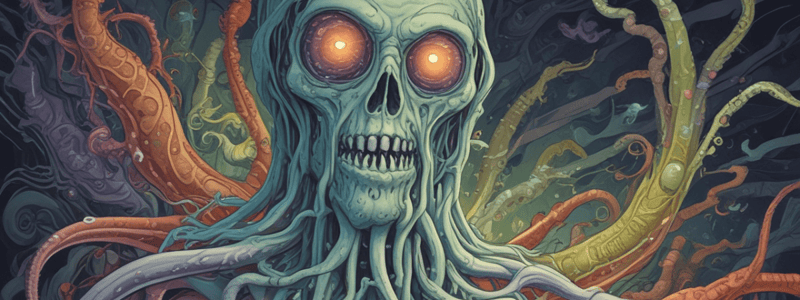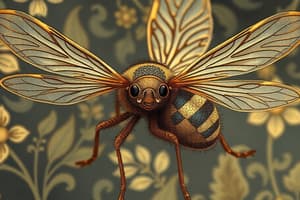Podcast
Questions and Answers
What is the typical length of a Pediculus humanus capitis (Head Lice)?
What is the typical length of a Pediculus humanus capitis (Head Lice)?
- 2.3-3.6 mm
- 1.1-1.8 mm
- 5-6 mm
- 2-3 mm (correct)
What is the main mode of transmission of body lice infestations?
What is the main mode of transmission of body lice infestations?
- Through contact with infected animals
- Through airborne transmission
- Through contaminated food and water
- Through close person-to-person contact (correct)
What is a common symptom of body lice infestation?
What is a common symptom of body lice infestation?
- Fever and chills
- Vomiting and diarrhea
- Intense itching and rash (correct)
- Headache and fatigue
What is the primary characteristic of ectoparasites?
What is the primary characteristic of ectoparasites?
Which of the following statements about head lice is true?
Which of the following statements about head lice is true?
Which class does Fleas, Lice, and Bedbugs belong to?
Which class does Fleas, Lice, and Bedbugs belong to?
What is the primary habitat of body lice?
What is the primary habitat of body lice?
What is the order of Lice?
What is the order of Lice?
What is a potential complication of body lice infestation?
What is a potential complication of body lice infestation?
What is the main difference between head lice and body lice?
What is the main difference between head lice and body lice?
What is a characteristic of insects?
What is a characteristic of insects?
How long does it take for itching to appear after a person gets head lice for the first time?
How long does it take for itching to appear after a person gets head lice for the first time?
What is the body structure of insects?
What is the body structure of insects?
Why are body lice infestations more common in certain populations?
Why are body lice infestations more common in certain populations?
What is the primary way head lice infestation is spread?
What is the primary way head lice infestation is spread?
How long can head lice survive if they fall off a person and cannot feed?
How long can head lice survive if they fall off a person and cannot feed?
What is a characteristic of Arachnida?
What is a characteristic of Arachnida?
What is the classification of Lice?
What is the classification of Lice?
What is the nickname of pubic lice?
What is the nickname of pubic lice?
How are pubic lice typically spread?
How are pubic lice typically spread?
What is a characteristic of Lice?
What is a characteristic of Lice?
What is the typical symptom of pubic lice infestation?
What is the typical symptom of pubic lice infestation?
What is unique about the front legs of pubic lice?
What is unique about the front legs of pubic lice?
What is NOT a way that head lice can be spread?
What is NOT a way that head lice can be spread?
What is the primary method of treating body lice?
What is the primary method of treating body lice?
What is the minimum temperature required to kill lice and eggs when washing clothes?
What is the minimum temperature required to kill lice and eggs when washing clothes?
What is the purpose of using a magnifying lens when checking for lice?
What is the purpose of using a magnifying lens when checking for lice?
What is the function of some pediculicides?
What is the function of some pediculicides?
What is a characteristic of adult bed bugs that have recently fed?
What is a characteristic of adult bed bugs that have recently fed?
Why is it important to wash and dry hats, scarves, pillowcases, bedding, clothing, and towels?
Why is it important to wash and dry hats, scarves, pillowcases, bedding, clothing, and towels?
What is unique about the antennae of true bugs?
What is unique about the antennae of true bugs?
What is the recommended frequency for changing clean clothes worn by the infested person?
What is the recommended frequency for changing clean clothes worn by the infested person?
What is the name of the medicinal ingredient used in some lice-killing lotions?
What is the name of the medicinal ingredient used in some lice-killing lotions?
What is the purpose of Integrated Pest Management (IPM)?
What is the purpose of Integrated Pest Management (IPM)?
What is the recommended action after vacuuming to reduce bed bug populations?
What is the recommended action after vacuuming to reduce bed bug populations?
What is the name of the FDA-approved medicinal ingredient for treating lice?
What is the name of the FDA-approved medicinal ingredient for treating lice?
What is the characteristic of young bed bugs (nymphs) when they have not fed recently?
What is the characteristic of young bed bugs (nymphs) when they have not fed recently?
What is the purpose of installing bed bug interceptors?
What is the purpose of installing bed bug interceptors?
What is a characteristic of bed bug eggs?
What is a characteristic of bed bug eggs?
What is essential for all stages of Cimex spp.?
What is essential for all stages of Cimex spp.?
Flashcards are hidden until you start studying
Study Notes
Ectoparasites
- Ectoparasites are pathogens that infect only the superficial layers of the skin, attaching or burrowing into the skin and remaining there for relatively long periods of time.
Classification of Ectoparasites
- Class: Insecta (Fleas, Lice, and Bedbugs)
- Class: Arachnida (Ticks and Mites)
Characteristics of Insecta
- Chitinous exoskeletons
- Three-part bodies (divided into head, thorax, and abdomen)
- Three pairs of legs
- Two antennae
Lice
- Kingdom: Animalia
- Phylum: Arthropoda
- Class: Insecta
- Order: Phthiraptera
Biology of Lice
- Small, wingless, blood-sucking ectoparasites of mammals and birds
- Prevalence: Low standard hygiene
- Infestation: Pediculosis
- Have humans as their only host
- Have similar life cycles
- Morphology: Body Dorso-ventrally flattened, 3 parts: Head - Thorax - Abdomen
Types of Lice
- Head lice: Pediculus humanus capitis (2-3 mm long)
- Body lice: Pediculus humanus corporis (2.3-3.6 mm long)
- Pubic lice (crabs): Pthirus pubis (1.1-1.8 mm long)
Body Lice
- Also known as Pediculus humanus humanus
- Adult body lice are 2.3–3.6 mm in length
- Live and lay eggs on clothing and only move to the skin to feed
- Symptoms: Intense itching and rash caused by an allergic reaction to louse bites
- Can transmit disease (epidemic typhus, Bartonella quintana infection, and epidemic relapsing fever)
Head Lice
- Not known to transmit any disease
- Symptoms: Itching (“pruritus”) - caused by an allergic reaction to louse bites
- Infestation: Pediculosis
- Spread: Close person-to-person contact
- Not transmitted by animals
Pubic Lice
- Pubic (“crab”) lice: Dorsoventrally-flattened
- Adults are much broader in comparison to head and body lice
- Second and third legs have a large modified claw with a thumb-like projection, used for grasping on to hair shafts
- Symptoms: Itching (“pruritus”) in the pubic and groin area
- Spread: Through sexual contact, close personal contact, or contact with materials used by an infested person
Treatment of Lice
- Body Lice: Improve personal hygiene, assure regular change of clean clothes
- Head Lice: Use pediculicides (medicines that kill lice), routine retreatment recommended
- Pubic Lice: Use lice-killing lotion containing 1% permethrin or a mousse containing pyrethrins and piperonyl butoxide
Bedbugs
- Adult bed bugs: About the size of an apple seed (5-7 mm or 3/16 - 1/4 inch long), brown, with a flat, oval-shaped body
- Young bed bugs (nymphs): Smaller, translucent or whitish-yellow in color
- Bed bug eggs: Tiny, pearl-white in color, marked by an eye spot if more than five days old
Life Cycle of Bedbugs
- Two species of bed bugs (Insecta: Hemiptera: Cimicidae) implicated in human infestations: Cimex lectularius and C. hemipterus
- Adults and all nymphal stages need to take blood meals from warm-blooded hosts, typically humans
Control Measures for Bedbugs
- Integrated Pest Management (IPM): Environmentally sensitive approach to pest management that relies on knowledge of the pest and a combination of common-sense practices
- Environmental Modification: Vacuuming, sealing cracks, using barriers, and judicious use of pesticides if needed
Studying That Suits You
Use AI to generate personalized quizzes and flashcards to suit your learning preferences.




